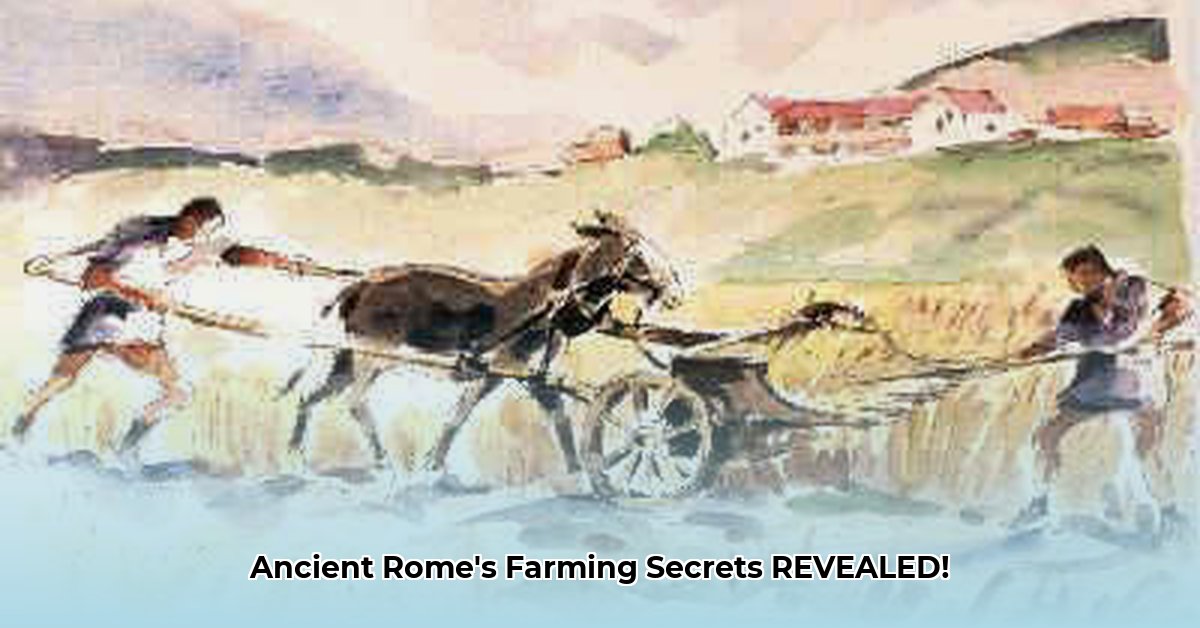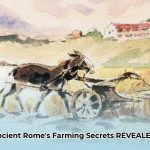How did an empire as vast and enduring as ancient Rome manage to sustain its millions, from bustling city dwellers to formidable legionaries? It wasn’t merely through military might or administrative genius. The Romans, renowned as master builders and strategists, were equally profound agriculturalists, forging practices that underpinned their monumental expansion and sustained daily life for over a millennium. Imagine their landscapes: golden wheat swaying under the Mediterranean sun, olive groves stretching across sun-drenched hills, and vineyards clinging to terraced slopes, yielding the very essence of their diet and culture. Yet, their agricultural narrative is not solely one of triumph; it also encompasses challenging labor systems, unforeseen environmental consequences, and complex logistical puzzles. Learn more about farming in Rome and its practices. What timeless wisdom, then, might these ancient fields still impart to us today, as we grapple with the pressing global challenges of feeding our own burgeoning population sustainably and ethically?
The Empire’s Granary: Core Crops and Dietary Staples
The daily diet of a Roman, from the humble plebeian selling wares in the forum to the esteemed senator debating in the Curia, was fundamentally simple and remarkably grain-centric. Wheat, particularly durum and emmer, alongside barley, formed the absolute backbone of their sustenance, often providing as much as 70 to 80 percent of their daily caloric intake. Durum wheat, prized for its ability to be baked into leavened bread, became especially favored in urban centers, while hardy barley thrived in poorer soils and served as crucial animal fodder.
While grains reigned supreme, olives, yielding their invaluable oil, and grapes, transformed into ubiquitous wine, were culturally pervasive and economically vital. Olive oil alone contributed about 12 percent of calories and 80 percent of necessary fats to the average Roman diet. Viticulture, though possibly introduced by Greek colonists, gained immense sophistication through Carthaginian influence, leading to widespread cultivation on large estates by 160 BC. Wine became a universal drink, and its production was so significant that Rome initially tried to restrict grape cultivation outside Italy to protect its domestic industry. Beyond this triad, Romans cultivated an astonishing variety of legumes—including lentils, peas, beans, and chickpeas—as well as an array of vegetables and fruits such as turnips, cabbage, lettuce, figs, and apricots, ensuring a diverse if not always luxurious diet.
This profound reliance on a few key energy-dense crops prompts a crucial question for our modern age: What insights can such a focused dietary strategy offer us? In an era frequently characterized by industrial monocultures, the Roman emphasis on dietary staples underscores the importance of a stable and reliable food source. Modern agriculture can glean a vital lesson here: diversifying crops isn’t merely about culinary variety; it is a strategic imperative for resilience. Such diversification can bolster ecosystem health, support biodiversity, and build a more robust food system for both human well-being and planetary health.
Ingenuity in the Fields: Roman Farming Techniques and Water Management
The Romans were far more than just prodigious laborers; they were thoughtful innovators in the realm of agriculture, displaying a sophisticated understanding of soil health and productivity. They keenly practiced crop rotation, a foundational technique involving the sequential planting of different crops in the same field. This ingenious method prevented the soil from becoming depleted of essential nutrients, while also naturally mitigating pests and diseases, ensuring healthier, more consistent yields across various soil types. Columella, a prominent Roman agronomist, even noted that certain crops like lupinus were particularly beneficial for fertilizing exhausted soil. They also understood the value of different types of manure, with poultry manure considered the best, and cow manure deemed less effective than that from sheep, goats, or donkeys.
Beyond the vital concerns of soil, their mastery of water was truly transformative. While Roman aqueducts are justly celebrated for supplying cities with fresh drinking water, their equally vital, if less heralded, role was in agriculture. These vast networks channeled water over immense distances, irrigating parched fields and transforming arid landscapes into fertile farmlands. In dry regions like North Africa, farmers constructed intricate irrigation ditches and cisterns to efficiently manage precious water resources. This sophisticated water management allowed for intensified and more diverse crop cultivation, directly boosting food production. Their tools, though seemingly rudimentary by modern standards, were remarkably effective and evolved over time. Farmers used the ard (a simple plough), sickles for harvesting, hoes for weeding, and specific pruning knives for vines. Perhaps the most significant innovation was the moldboard plow (though its widespread adoption in Italy is debated), which allowed for deeper turning of the soil, improving aeration and drainage. In colder northern Gaul, an automatic harvester called the “vallus” was even invented, though its high cost limited widespread adoption.
The Romans’ profound expertise in water management and their continuous innovation remain exceptionally relevant today. In a world grappling with increasing water scarcity and escalating droughts across continents, their efficient methods of water distribution and utilization offer a critical historical blueprint. Modern agriculture must prioritize cutting-edge irrigation techniques and sustainable water infrastructure development to ensure robust food security for a growing global population. The Roman example underscores the necessity of continuous agricultural innovation and the adoption of sustainable farming practices that respect the land’s long-term viability.
The Hidden Cost: Labor, Land, and Society
To paint a complete picture of ancient Rome’s agriculture, one must acknowledge its darker side: the pervasive reliance on slave labor. While small, family-owned farms, largely self-sufficient, were common in early Rome, the empire’s burgeoning population and expansive food needs were primarily sustained by vast agricultural estates known as latifundia. These sprawling plantations, often exceeding 500 iugera (approximately 325 acres), were critically dependent on enslaved individuals for planting, harvesting, and processing crops. Wealthy Romans acquired land from peasant farmers, often called away for military service during the Punic Wars, contributing to increasing economic inequality. Free men and citizens were sometimes hired to oversee these slave forces, ensuring smooth operations.
The management of slave labor was brutally efficient. Authors like Cato the Elder, in his De Agri Cultura, outlined cold, calculated directives for managing slaves, treating them much like valuable livestock with specific rations of grain, wine, and clothing. Such detailed instructions reveal the institutionalized nature of forced labor. The concentration of land ownership among the aristocracy was a dominant factor distinguishing them from common citizens; the more land a Roman owned, the greater his prominence in the city. Soldiers returning from campaigns were often rewarded with land, further entrenching the link between military success and agricultural wealth. This raises a fundamental question: at what human cost did Rome feed itself?
We stand at a historical vantage point, compelled not to repeat the ethical missteps of the past. Prioritizing ethical labor practices within our contemporary food systems is not merely a moral imperative but a pathway to long-term societal stability. Furthermore, the historical concentration of land ownership among a select few, as seen in the latifundia, often exacerbated economic inequalities and fueled social unrest, as evidenced by mass evictions of the poor that contributed to civil wars. Today, fostering fair labor practices and promoting more equitable access to land are crucial steps toward building a just and sustainable agricultural future.
Feeding the Metropolis: Trade, Logistics, and the Cura Annonae
Despite its agricultural prowess within Italy, Rome was not self-sufficient. To feed its burgeoning population, particularly within the massive city of Rome itself (estimated at one million people at its peak), it relied heavily on significant grain imports from its far-flung provinces. Regions like Egypt, North Africa (especially Carthage’s hinterland), and Sicily served as imperial breadbaskets, with Egypt alone providing grain for four months of the year, and North Africa for eight. This reliance on distant supplies necessitated a strategic response, and the Roman government introduced the Cura Annonae (care of the grain supply) to secure the city’s food supply. This prompts a vital contemporary question: what can this ancient system reveal about the strategic importance of food security in any era?
The Cura Annonae was Rome’s elaborate state-sponsored system designed to guarantee grain distribution and prevent mass starvation. Emperors took direct oversight, organizing vast grain fleets, constructing immense storage facilities (horrea), and distributing grain—and later, baked bread—to Roman citizens, often at subsidized prices or even freely. Initiated by Gaius Gracchus in 123 BC to stabilize prices, it evolved into a free dole by 58 BC under Clodius. By the time of Julius Caesar, around 320,000 people received free grain, a number later stabilized by Augustus at around 200,000. While it undoubtedly served as a form of social welfare, it also acted as a potent political tool, helping to maintain order and placate the populace. Though impressive in scale, this system also highlighted vulnerabilities. Over-reliance on distant provinces left Rome susceptible to disruptions. When, for instance, the Vandals seized North Africa in 439 AD, effectively cutting off a crucial grain supply, the system faced immense strain, contributing to the empire’s challenges.
The logistics involved were astounding. Grain was transported across vast maritime trade networks and extensive road systems, eventually reaching massive urban mills. A notable example is the Barbegal watermill complex in southern France, which, from the late 1st to late 3rd centuries AD, utilized sixteen overshot water wheels to produce an estimated 4.5 tons of flour daily—enough to supply 12,500 inhabitants.
Food security must remain a paramount strategic goal for every nation. Over-reliance on a single region or excessive imports can expose a country to immense risks from geopolitical instability, climate events, or economic disruptions. The Roman experience underscores the delicate balance between free markets and necessary government intervention in agriculture to ensure universal access to food. We must learn not to depend solely on single regions for our dietary staples and to build diverse, resilient supply chains.
Beyond Sustenance: Culture, Religion, and Environmental Footprints
For the Romans, agriculture was never solely a means of survival; it was profoundly interwoven with their cultural and religious identity. Cicero, the great orator, idealized farming as the “best of all Roman occupations,” teaching “economy, industry, and justice.” Religious festivals, honoring deities like Ceres (goddess of grain and fertility), Saturn (god of sowing and time), and Bacchus (god of wine), were inextricably tied to the agricultural calendar. Cerialia and Saturnalia, for instance, were marked by sacrifices, games, and communal feasting, symbolizing the Romans’ belief in divine favor as essential to successful farming. These communal customs celebrated bountiful harvests and sought divine blessings for future yields, strengthening the vital bond between the people, their land, and their spiritual beliefs.
In our fast-paced modern world, many of us have become profoundly disconnected from the source of our food. Reconnecting with the rhythms of the farming cycle, celebrating the tireless efforts of food producers, and truly valuing fresh produce can foster a stronger sense of community and deepen our appreciation for the environment that sustains us. However, the Romans’ intensive farming methods, while highly effective in the short term, likely incurred significant long-term environmental costs. Evidence suggests that extensive deforestation for timber and agricultural land, coupled with continuous cultivation, led to widespread soil erosion, particularly on hillsides. Irrigation systems, while innovative, could also contribute to salinization in arid regions if not properly managed. These were unintentional but significant consequences of their drive for agricultural output.
Sustainability must therefore be at the forefront of all modern agricultural practices. From the Roman experience, we can learn invaluable lessons by striving to avoid the ecological missteps of past civilizations. Prioritizing environmental stewardship—care of the soil, responsible water use, protection of natural habitats, and diversification of ecosystems—is not merely an environmental concern; it is the fundamental cornerstone of long-term food security for all.
Enduring Legacy: Lessons for the Future
The agricultural legacy of ancient Rome offers a profound mirror for our modern food systems. By understanding their remarkable innovations, their logistical triumphs, and their critical societal and ecological missteps, we gain invaluable insights into building a more sustainable and equitable future. The principles of crop rotation, efficient water management, and the crucial role of government in ensuring food security remain as pertinent today as they were two millennia ago. Simultaneously, the historical reliance on exploitative labor and the environmental consequences of unchecked expansion serve as powerful cautionary tales.
The Roman agricultural system, a complex tapestry of human ingenuity and immense natural resources, powered an empire that shaped Western civilization. Its study reveals that the challenges of feeding a growing population, balancing economic demands with social equity, and sustaining natural resources are timeless. Indeed, the fields of ancient Rome continue to hold secrets—not just of a bygone empire, but of a shared human journey to feed ourselves, a journey that demands our careful attention to both the harvest and the hands that bring it forth, today and for generations to come.
- Uncover ancient roman shield tactics for legionary dominance: military history revealed - August 18, 2025
- Unveiling the Ancient Roman Bed: Trends Influencing Modern Design Today [Historical Reference] - August 18, 2025
- Conquer the Seas: Ancient Roman Ships’ Naval Rise & Legacy Today - August 18, 2025
















